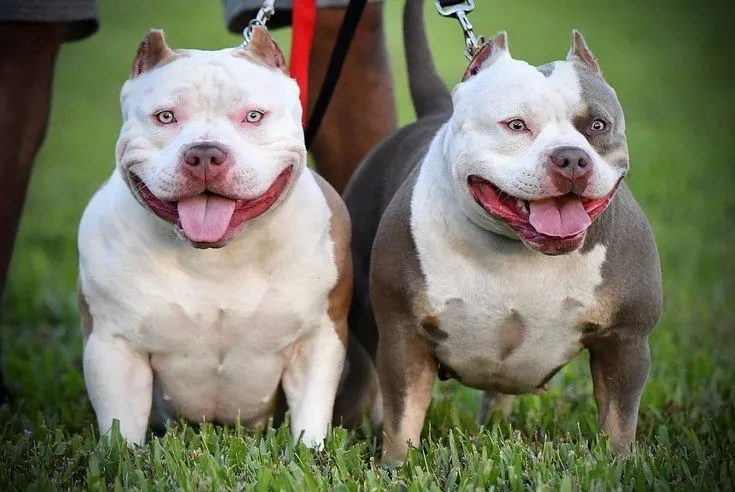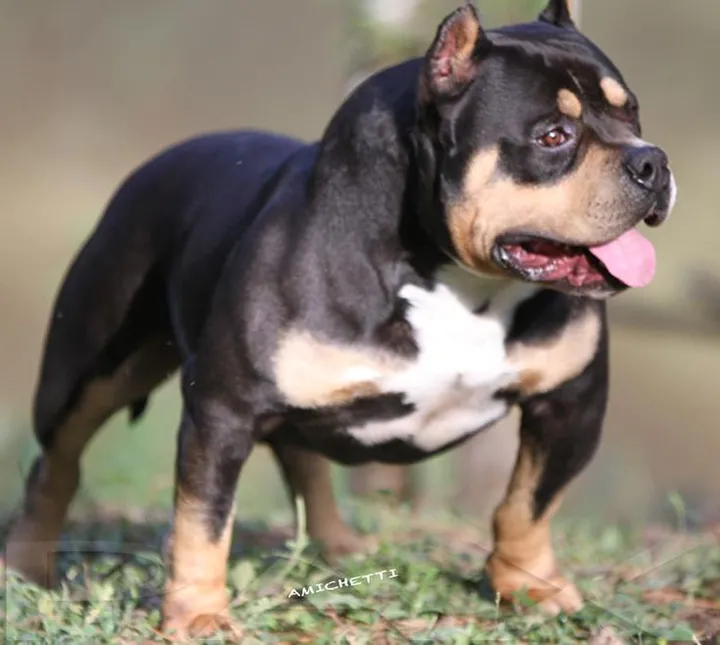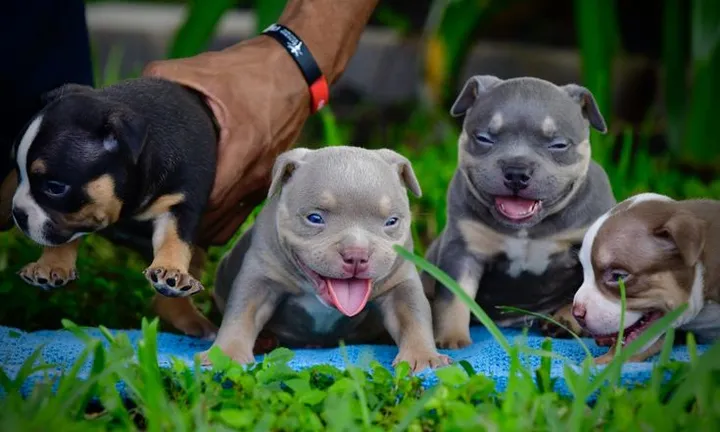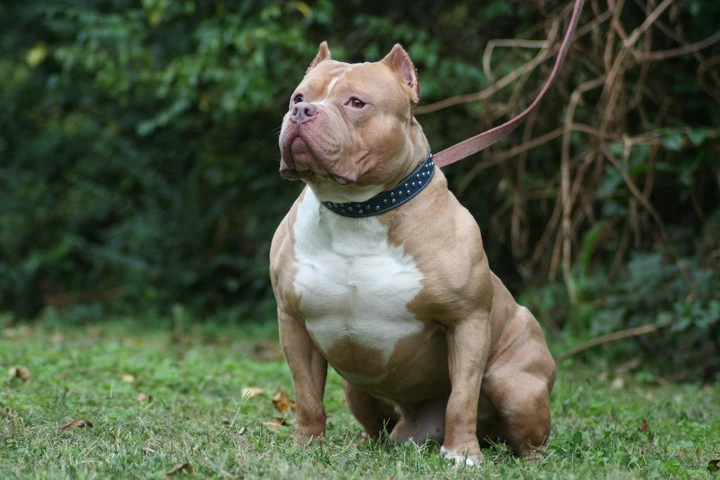In the diverse world of canines, few breeds capture attention quite like the tri-colored bullies. With their striking coat patterns and muscular build, these dogs are turning heads and winning hearts across the globe. Whether you’re a seasoned dog owner or considering your first furry companion, this comprehensive guide will walk you through everything you need to know about these remarkable animals.
Unveiling the Tri-Colored Bully
The tri-colored bully, a captivating variant of the American Bully breed, has been making waves in the dog world with its distinctive appearance and endearing personality. But what exactly sets this canine apart from its cousins?
Defining Characteristics
Tri-colored bullies boast a unique coat pattern featuring three distinct colors. This eye-catching combination typically includes:
A primary base color
A secondary color
White markings
The specific colors can vary, but common combinations include:
1. Black, tan, and white
2. Blue, fawn, and white
3. Chocolate, tan, and white
These dogs inherit their muscular build and broad head from their American Bully lineage, but it’s their tri-color coat that truly sets them apart.
Genetic Makeup
The tri-color coat pattern in bullies results from a complex interplay of genes. The specific combination of alleles determines not only the presence of three colors but also their distribution across the dog’s body.
“Genetics play a fascinating role in coat color variation. The tri-color pattern is a result of specific gene interactions that are still being studied by canine geneticists,” says Dr. Emma Thompson, a veterinary geneticist.
Recognized Color Combinations
While tri-colored bullies can sport various color combinations, some are more sought-after than others. Here’s a breakdown of popular and rare variants:
|
Popularity |
Color Combination | Description |
|
High |
Black, tan, white |
Classic tri-color look |
|
High |
Blue, fawn, white |
Striking blue-based pattern |
|
Medium |
Chocolate, tan, white |
Rich, warm-toned variant |
| Rare | Lilac, champagne, white |
Dilute color combination |
| Very Rare | Merle tri-color |
Mottled pattern with three colors |
Tri-Colored Bully vs. Other Bully Breeds
To truly appreciate the tri-colored bully, it’s essential to understand how they compare to their close relatives in the bully family.
Key Distinctions from American Bullies
While tri-colored bullies are a color variant of the American Bully, they share many physical traits with their single or bi-colored counterparts. The main difference lies in their coat pattern. Here’s a quick comparison:
Body Structure: Both share a muscular, compact build
Head Shape: Wide, blocky head typical of the bully breed
Temperament: Generally similar friendly and loyal nature
Coat: Tri-colored bullies have three distinct colors, while standard American Bullies typically have one or two colors
Comparison with Pit Bulls
It’s a common misconception that tri-colored bullies are the same as pit bulls. While they share some ancestry, there are notable differences:
Tri-Colored Bully
Broader, more muscular build
Shorter muzzle
Three-color coat pattern
Typically heavier
Pit Bull
More athletic, leaner build
Longer muzzle
Usually single or bi-colored
Generally lighter weight
Breed Classification Debates
The classification of tri-colored bullies has been a topic of discussion among breed enthusiasts and kennel clubs. While they’re recognized as part of the American Bully breed, some argue for a separate classification due to their unique coat patterns.
The Tri-Colored Bully Experience
Owning a tri-colored bully is more than just having a visually stunning pet. These dogs come with their own set of personality traits and needs that potential owners should be aware of.
Temperament and Personality Traits
Tri-colored bullies are known for their
Loyalty: They form strong bonds with their families
Friendliness: Generally good-natured with people
Confidence: Self-assured and steady in various situations
Playfulness: Enjoy interactive play and activities
“My tri-colored bully, Max, is the gentlest soul. He’s great with kids and has an endless supply of love for everyone he meets,” shares Sarah, a proud tri-colored bully owner.
Intelligence and Trainability
These dogs are typically: Quick learners
Eager to please their owners
Responsive to positive reinforcement techniques
However, they can also be stubborn at times, requiring patience and consistency in training.
Energy Levels and Exercise Needs
Tri-colored bullies have moderate to high energy levels. To keep them happy and healthy, plan for
Daily walks (30-45 minutes)
Play sessions
Mental stimulation activities
Case Study: Jake’s Tri-Colored Bully Fitness Routine
Jake, a tri-colored bully owner, shares his dog’s daily exercise routine:
1. Morning: 20-minute brisk walk
2. Afternoon: 15-minute fetch or tug-of-war session
3. Evening: 30-minute neighborhood stroll
4. Throughout the day: Short training sessions and puzzle toys
This routine keeps Jake’s bully physically fit and mentally stimulated.
Socialization Importance
Early and ongoing socialization is crucial for tri-colored bullies. It helps them:
Develop good manners around other dogs and people
Adapt to various environments
Reduce the likelihood of fear-based behaviors
Physical Attributes and Care
Understanding the physical characteristics of tri-colored bullies is key to providing them with proper care.
Size and Weight Ranges
Tri-colored bullies come in various sizes, typically categorized as:
1. Pocket: 14-17 inches tall, 30-40 lbs
2. Standard: 17-20 inches tall, 50-70 lbs
3. XL: 20-23 inches tall, 80-120 lbs
4. XXL: 23+ inches tall, 120+ lbs
Nutrition and Dietary Requirements
A balanced diet is crucial for tri-colored bullies. Consider:
High-quality protein sources
Appropriate fat content
Limited fillers and artificial additives
Portion control to prevent obesity
Exercise Routines for Optimal Health
Regular exercise is vital for tri-colored bullies. A well-rounded routine should include:
1. Daily walks
2. Playtime (fetch, tug-of-war)
3. Swimming (if available)
4. Agility training
Remember to adjust exercise intensity based on your dog’s age, health status, and the weather conditions.
Living with a Tri-Colored Bully
Bringing a tri-colored bully into your home is a big decision. Here’s what you need to know about cohabiting with these charismatic canines.
Space Requirements
While they can adapt to various living situations, tri-colored bullies thrive in homes with:
A securely fenced yard
Ample indoor space for play and relaxation
A designated sleeping area
Family Compatibility
Tri-colored bullies often make excellent family pets. They are:
Patient with children (when properly socialized)
Affectionate with family members
Protective of their home
However, always supervise interactions between dogs and young children.
Interaction with Other Pets
With proper introduction and socialization, tri-colored bullies can coexist well with other pets. Consider:
Gradual introductions
Supervised interactions initially
Separate feeding areas
Equal attention to all pets
Adapting to Different Climates
Tri-colored bullies have short coats that offer limited protection against extreme weather. In hot climates:
Provide plenty of shade and water
Avoid exercise during peak heat hours
Consider cooling mats or vests
In cold weather:
Limit outdoor time
Use doggy sweaters or coats
Protect paw pads from ice and salt
Training Your Tri-Colored Bully
Proper training is essential for a well-behaved tri-colored bully. Here are some key aspects to focus on:
Effective Training Techniques
Positive reinforcement
Consistency in commands
Short, frequent training sessions
Use of high-value treats
Common Behavioral Challenges
Some tri-colored bullies may exhibit:
1. Stubbornness
2. Overprotectiveness
3. Chewing behaviors
4. Pulling on leash
Address these issues early with consistent training and positive reinforcement.
Positive Reinforcement Strategies
Effective methods include:
Clicker training
Treat rewards
Verbal praise
Favorite toys as rewards
Professional Training Options
Puppy socialization classes
Basic obedience training
Advanced training for specific skills
One-on-one sessions with a professional trainer
Conclusion: Is a Tri-Colored Bully Right for You?
Tri-colored bullies are stunning, affectionate, and loyal companions. They offer:
A unique and eye-catching appearance
Strong bonds with their families
Playful and energetic personalities
Potential for excellent trainability
However, they also require:
Consistent training and socialization
Regular exercise and mental stimulation
Attention to potential health issues
Financial commitment for proper care
Ultimately, if you’re prepared for the responsibilities and joys of owning a tri-colored bully, you’ll likely find them to be a rewarding and loving addition to your family.
Remember, every dog is an individual. While this guide provides general information about tri-colored bullies, each dog will have its own unique personality and needs. Careful consideration, preparation, and commitment are key to a successful and happy relationship with your tri-colored bully companion.
FAQS
Q:Are tri color pitbulls expensive?
A:It can be a bit expensive
Q:Are tri-color bullies rare?
A:Relatively rare
Q:Which Pitbull is the rarest?
A:Lilac Pit Bulls









